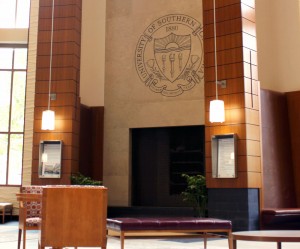Campus center first LEED-certified building at USC
The Ronald Tutor Campus Center is not only the newest building on USC’s campus, but also the greenest.

Lasting impact · The campus center is LEED-certified for its sustainable features, including ventilation, long-life lightbulbs, use of natural lighting and toxic-free paints. - Ted Gerike | Daily Trojan
For the first time at USC, a building received a Leadership in Energy and Environmental Design certificate.
“We spend 90 percent of our time in buildings,” said Lance Williams, Ph.D., former USC professor and current executive director of the Los Angeles chapter of the Green Building Council, the national organization that distributes the award. “The way to regulate the amount of energy and harmful impact of greenhouse gases is by starting with buildings.”
An average LEED-certified building saves 30 to 40 percent on energy use and creates 70 percent less solid waste, according to Williams.
The campus center is about 30 percent more energy efficient than the standards demanded by the state, said Stan Westfall, project manager for the campus center.
Administrators decided they wanted the campus center to be LEED certified before a shovel had even touched dirt.
“[It was] way before we were doing blueprints, before the initial documents,” Westfall said.
Westfall said he believes integrating LEED-certifiable features into the campus center was easier because of early planning by the administration and construction company.
At about $2,000, a LEED certification is no small cost, but the designation brings green credibility, Williams said.
Three levels of certificate — silver, gold and platinum — are given based on performance in a variety of categories, including water efficiency and indoor environmental quality. USC’s building received a silver designation.
“We were able to pay special attention when we did some early demolition to recycle a large percentage,” Westfall said. “We also bought a lot of materials locally.”
Water preservation was also a key factor for the certification. At night and in off-hours a water reservoir found below Cromwell Field filters and transports water to the campus center.
But some students don’t think the building seems any greener than others on campus.
“It’s hard to say,” said Lucas Boyd, a senior majoring in political science. “I haven’t seen anything that indicates it’s sustainable.”
Although key aspects to the building’s award were its use of natural light, good ventilation and use of non-toxic paint, most of the LEED implementations aren’t noticeable. Low-flow plumbing, trash compactors that separate out biodegradables and lighting with long-life bulbs are a few of the many examples.
Not every environmental application in the building might be visible to the untrained eye, but Williams said the impact a LEED building makes on the world is what’s truly important.
“It is essentially a recognition that the earth’s resources are finite,” he said. “So many people are concerned from a scientific as well as business and social perspective as to how to preserve and protect as many of the earth’s resources as possible.”
Williams said he hopes LEED certifications at USC will only increase in years to come.
“[A green environment] is a critical part of our world — it’s not an adjunct or a fad or something going away. It is a measure that has to continue to be promoted,” he said.
